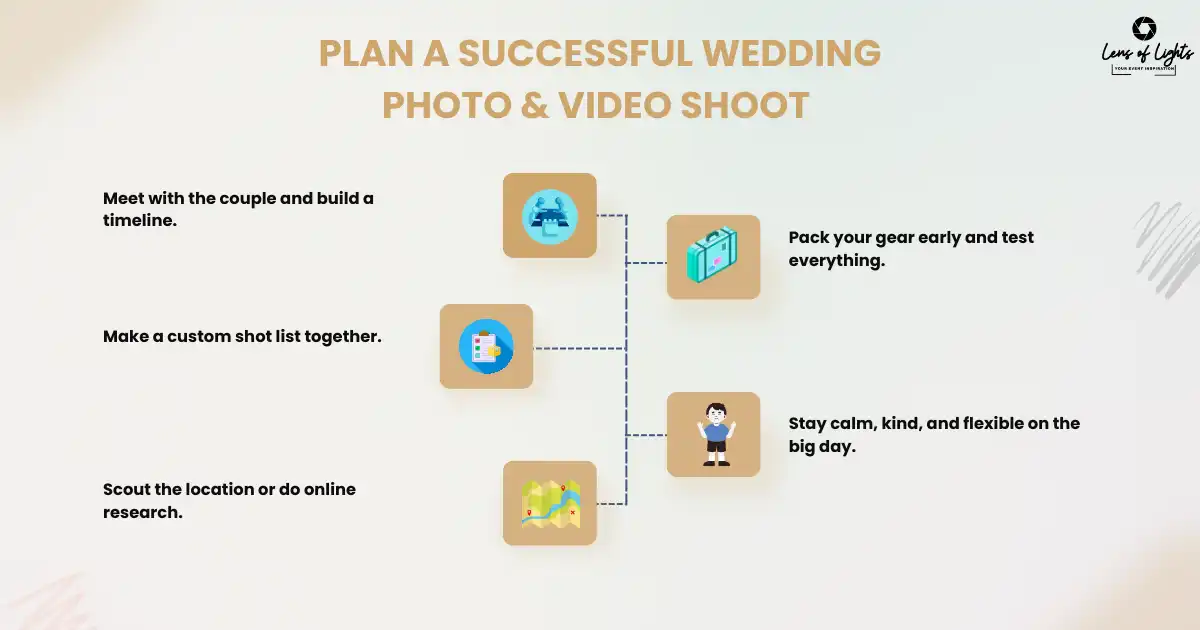
📸 How to Plan a Successful Wedding Photo & Video Shoot – For Photographers
After a couple hires you, your job as a photographer or videographer really begins. The wedding day is emotional and full of surprises. If you’re not prepared, you could miss important moments or get overwhelmed. But don’t worry! With careful planning, you can handle everything smoothly—even if something unexpected happens.
✨ Episode 2:
Preparing for the Big Day – Timeline, Gear & Client Expectations
This episode will help you organize your timeline, get your gear ready, and understand your couple’s expectations so you can feel confident and do your best work.
✅ Step-by-Step Preparation Guide
- Create a Clear Timeline with the Couple
When a couple contacts you, it usually means they’re also talking to other photographers. If you take too long to reply, they might move on.
✅ 1. Create a Clear Timeline with the Couple.

Why this matters:
Weddings are busy and fast. If you don’t know where to be or when, you might miss a key moment—like the first kiss or the father-daughter dance. A timeline helps you plan your movements throughout the day.
What to do:
- Contact the couple about 2–3 weeks before the wedding.
- Set a time to talk on Zoom, by phone, or in person.
- Ask them to go through the day from start to finish.
Questions to ask:
- What time is the ceremony?
- What time will the bride and groom get ready? Where?
- Are they doing a first look before the ceremony?
- What time is the reception, dinner, and first dance?
- Are there any special or surprise moments planned?
Also ask:
Will there be multiple locations (like a separate getting-ready room, ceremony venue, and reception hall)? If yes, ask about the travel time between each.
Pro Tips:
Ask if they have a wedding planner or coordinator. Often, planners have a full printed schedule (itinerary) with times, names, and locations that you can use.
✅ 2. 📋 Make a Shot List Together
Why this matters:
Couples often assume you’ll know who and what to photograph. But each wedding is different. A shot list ensures you don’t miss important family members, traditions, or moments the couple deeply cares about.
How to do it:
- Sit with the couple and ask them to list the key people and moments they want photos or videos of.
- Go through each part of the day (getting ready, ceremony, family portraits, reception) and ask what’s important to them.
Examples of common must-have shots:
- Bride with mom and dad
- Groom with his brothers
- Bride and her grandmother
- Couple with close friends
- Candid moments – laughing, hugging, crying
- First look between bride and groom
- Walking down the aisle
- Ring exchange and first kiss
- First dance
- Speeches and reactions
- Cutting the cake
Pro Tips:
Print the list or save it on your phone/tablet. If you’re working with a second shooter, give them a copy too. That way, you won’t forget anything, even when the day gets hectic.
🎁 Final Thought:
Meeting the couple is your first chance to earn their trust. If they feel comfortable with you now, they’ll feel relaxed on the wedding day—and that means better photos, better videos, and happier clients.
✅ 3. 🔍 Scout the Location (If Possible)
Why this matters:
Every venue is different. By checking the location before the wedding, you can plan where to take the best photos or videos. You’ll know where the light looks good, where people can gather for group shots, and where to hide if it rains.
How to do it:
- If the venue is nearby, visit it during the same time of day the wedding will take place.
- Walk through the key areas: getting ready rooms, ceremony space, reception hall, outdoor spots.
- Look at the lighting in each area. Is it too dark? Too bright?
- Find good places for portraits, group shots, or romantic moments.
Things to look for:
- Where the sun sets – great for golden hour photos.
- Indoor spaces with windows – for natural light if it rains.
- Locations for family group photos – flat, open, shaded areas are best.
- Where guests will be seated – so you can move around easily.
Can’t visit in person?
No problem. Ask the couple for:
- The venue name
- Photos or videos from past events
- A floor plan or layout if possible
Also search online for weddings at that venue to get ideas.
✅ 4. 🎒 Get Your Gear Ready
Why this matters:
Your equipment is your toolbox. If you forget something or it breaks, you might miss the most important part of the day. Being ready ahead of time avoids panic and lets you focus on your creative work.
When to start packing:
At least 2–3 days before the wedding. Don’t leave it for the night before!
Make a checklist of gear:
✔ Cameras
- Your main camera
- A backup camera (in case your main one fails)
✔ Lenses
- Wide-angle (for group shots or venue)
- Portrait (for couple and close-ups)
- Zoom lens (for ceremony from a distance)
✔ Batteries
- Charge all your batteries
- Bring at least 2–3 extra per camera
✔ Memory Cards
- Format them (delete all old files)
- Carry extra cards in case one fails or fills up
✔ Accessories
- Tripod, monopod, or gimbal (for stable video)
- Flash or LED lights (for low-light reception)
- Audio gear: mics, recorders, windshields (if filming)
- Drone + charger + permits (if using)
✅ Other Essentials
- Rain covers or umbrella
- Lens cleaning cloth
- Power bank or phone charger
- Small towel or hand wipes
- Water bottle and snacks – it’s a long day!
Night before tip:
Lay out your clothes, shoes, and bag. Pack everything neatly. Clean your lenses and do a quick test of your gear to make sure everything works.
✅ 5. 🧘♀️ Prepare Emotionally
Why this matters:
Weddings can be chaotic. People may be late, it might rain, or the schedule might get messed up. The couple and their families might feel nervous. Your job is to be the calm in the storm.
Be mentally prepared for :
- Changes in schedule
- Unexpected problems (missing flowers, late makeup artists)
- Emotional moments (crying parents, nervous bride/groom)
Your attitude is powerful :
- If you stay calm and smile, others will too.
- If something goes wrong, offer solutions, not stress.
- Speak gently and reassure the couple – they’ll remember your kindness forever.
Examples of positive responses:
- “Don’t worry, we’re flexible—we can adjust the timeline.”
- “Take a deep breath, you look beautiful, and everything is going to be perfect.”
- “Let’s step outside for a quiet shot—this moment is just for you two.”
✅ Summary of Episode 2 :

- Meet with the couple and build a timeline.
- Make a custom shot list together.
- Scout the location or do online research.
- Pack your gear early and test everything.
- Stay calm, kind, and flexible on the big day.
👉 Coming soon in Episode 3:
You’ll learn how to actually shoot the wedding day, how to tell a love story with your camera, work fast under pressure, manage large groups, and deliver stunning results that wow your clients.
